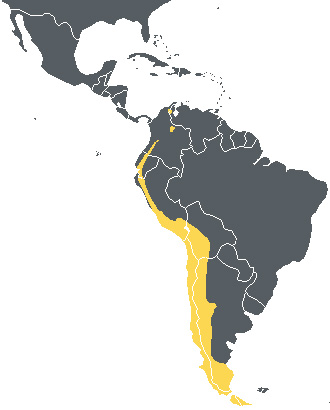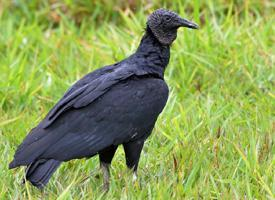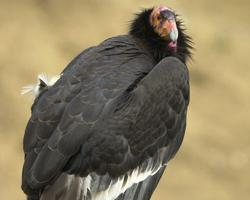
Poids et mesures
| Poids | de 8 à 10 kg |
|---|---|
| Envergure des ailes | 3,2 m |
Données biologiques
| Durée de vie | 100 r |
|---|
Description de l'animal
The Andean condor (Vultur gryphus) is a magnificent and emblematic bird of prey that graces the skies of the Andean mountains, symbolizing power and freedom across South America. This colossal bird is one of the largest flying birds in the world, thanks to its impressive wingspan, which can reach up to 3.3 meters (10.8 feet), allowing it to soar gracefully at high altitudes. The Andean condor is a member of the vulture family, and like its relatives, it plays a crucial role in the ecosystem as a scavenger, feeding primarily on carrion and thus preventing the spread of disease from dead animals.Physically, the Andean condor is distinguished by its striking appearance. Adults possess a predominantly black plumage, which contrasts sharply with the white ruff of feathers around the base of the neck and, in males, large white patches on the wings. One of the most distinctive features of the Andean condor is the head and neck, which are nearly featherless and can vary in color from a dull red to a vibrant yellow, depending on the bird's emotional state. Males are generally larger than females and have a distinctive comb on their heads, making them easily distinguishable.
The Andean condor's habitat extends across the mountainous regions of South America, from Venezuela and Colombia in the north, down through Ecuador, Peru, and Bolivia, to Chile and Argentina in the south. These birds favor open landscapes where they can ride thermal air currents, allowing them to ascend to dizzying heights of up to 5,500 meters (18,000 feet) above sea level without flapping their wings.
Andean condors have a slow reproductive rate, laying only one or two eggs every two to three years. They practice biparental care, with both the male and the female sharing responsibilities for incubating the egg and raising the chick. The young condors are dependent on their parents for over a year, which contributes to the species' slow population growth.
Despite their awe-inspiring presence and cultural significance in Andean societies, where they are often revered in mythology and folklore, Andean condors face several threats that have led to their classification as Near Threatened by the International Union for Conservation of Nature (IUCN). Habitat loss, poisoning from consuming carcasses of animals killed with lead bullets, and persecution due to perceived threats to livestock, are among the primary challenges they face. Additionally, the slow reproductive rate of the species means that population recovery is a slow process.
Conservation efforts are underway in several countries to protect the Andean condor, including breeding programs in captivity, education initiatives to change local perceptions, and legal protections. The survival of the Andean condor is not only crucial for maintaining the ecological balance in its habitat but also for preserving the cultural heritage of the Andean region.
In summary, the Andean condor is a symbol of majesty and resilience, soaring above the South American Andes. Its survival hinges on concerted conservation efforts to mitigate threats and safeguard the ecosystems that support this magnificent bird of
Carte de répartition

Animaux similaires
Nouvelles photos d'animaux
Top 10 des animaux
- Dolphin gull (Leucophaeus scoresbii)
- Diana monkey (Cercopithecus diana)
- Moustached guenon (Cercopithecus cephus)
- Galápagos tortoise (Geochelone nigra complex)
- Russian tortoise (Testudo horsfieldii)
- Japanese macaque (Macaca fuscata)
- Stone loach (Barbatula barbatula)
- Greek tortoise (Testudo graeca)
- Common flying dragon (Draco volans)
- Colossal squid (Mesonychoteuthis hamiltoni)


